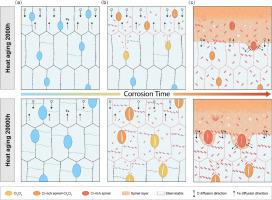当前位置:
X-MOL 学术
›
J. Mater. Sci. Technol.
›
论文详情
Our official English website, www.x-mol.net, welcomes your feedback! (Note: you will need to create a separate account there.)
Effect of long-term thermal aging on lead-bismuth eutectic corrosion behavior of 9Cr ferritic/martensitic steel
Journal of Materials Science & Technology ( IF 11.2 ) Pub Date : 2024-06-14 , DOI: 10.1016/j.jmst.2024.05.049 Yanyun Zhao , Shiao Ding , Yanyan Du , Kunjie Yang , Shaojun Liu
Journal of Materials Science & Technology ( IF 11.2 ) Pub Date : 2024-06-14 , DOI: 10.1016/j.jmst.2024.05.049 Yanyun Zhao , Shiao Ding , Yanyan Du , Kunjie Yang , Shaojun Liu

|
In lead-cooled fast reactor (LFR) systems, the liquid lead-bismuth eutectic (LBE) coolant provides a corrosive environment that damages the steel components during high-temperature operation. This study investigated the microstructural deterioration of 9Cr ferritic/martensitic (F/M) steel under thermal aging at 550 °C for 2,000, 10,000, or 20,000 h and its effect on oxidation corrosion in an LBE environment using multiscale characterization techniques. The results indicated that the thickness of the internal oxidation zone (IOZ) increased significantly with extended thermal aging, whereas that of the spinel layer remained relatively constant. The abundant subgrain boundaries that emerged during extensive thermal aging facilitated Fe diffusion, and the enlarged Cr-rich MC carbides contributed to the formation of preferential oxidation regions, accelerating IOZ layer growth. The spinel layer formed from the IOZ was influenced by microstructural defects within the IOZ. A theoretical model describing the accelerated oxide layer growth due to thermal aging was developed. These findings support the advancement of LFR technology.
中文翻译:

长期热时效对9Cr铁素体/马氏体钢铅铋共晶腐蚀行为的影响
在铅冷快堆(LFR)系统中,液体铅铋共晶(LBE)冷却剂提供了一个腐蚀性环境,在高温运行期间会损坏钢部件。本研究利用多尺度表征技术,研究了 9Cr 铁素体/马氏体 (F/M) 钢在 550 °C 热时效 2,000、10,000 或 20,000 小时下的微观结构恶化及其对 LBE 环境中氧化腐蚀的影响。结果表明,随着热老化时间的延长,内氧化区(IOZ)的厚度显着增加,而尖晶石层的厚度保持相对恒定。广泛的热老化过程中出现的丰富的亚晶界促进了 Fe 的扩散,而增大的富 Cr MC 碳化物有助于形成优先氧化区,加速了 IOZ 层的生长。由 IOZ 形成的尖晶石层受到 IOZ 内微观结构缺陷的影响。开发了描述由于热老化而加速氧化层生长的理论模型。这些发现支持了 LFR 技术的进步。
更新日期:2024-06-14
中文翻译:

长期热时效对9Cr铁素体/马氏体钢铅铋共晶腐蚀行为的影响
在铅冷快堆(LFR)系统中,液体铅铋共晶(LBE)冷却剂提供了一个腐蚀性环境,在高温运行期间会损坏钢部件。本研究利用多尺度表征技术,研究了 9Cr 铁素体/马氏体 (F/M) 钢在 550 °C 热时效 2,000、10,000 或 20,000 小时下的微观结构恶化及其对 LBE 环境中氧化腐蚀的影响。结果表明,随着热老化时间的延长,内氧化区(IOZ)的厚度显着增加,而尖晶石层的厚度保持相对恒定。广泛的热老化过程中出现的丰富的亚晶界促进了 Fe 的扩散,而增大的富 Cr MC 碳化物有助于形成优先氧化区,加速了 IOZ 层的生长。由 IOZ 形成的尖晶石层受到 IOZ 内微观结构缺陷的影响。开发了描述由于热老化而加速氧化层生长的理论模型。这些发现支持了 LFR 技术的进步。











































 京公网安备 11010802027423号
京公网安备 11010802027423号